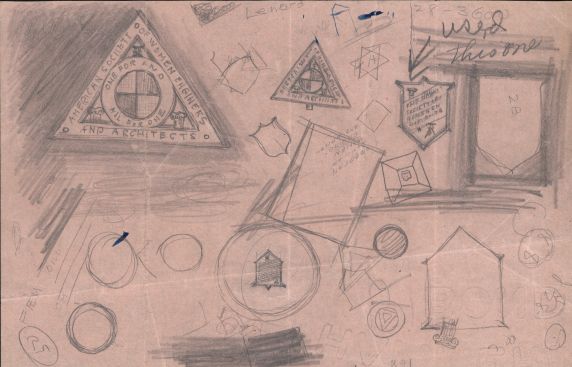Collection Spotlight: American Society of Women Engineers and Architects
In 1919, University of Colorado engineering students Lou Alta Melton and Hilda Counts wanted to establish an American Society of Women Engineers and Architects—a women’s auxiliary that would run alongside professional engineering and architectural organizations. They sent letters to every college engineering and architecture department they could identify, asking for information about any past or present women enrolled in those departments. Through their survey, Melton and Counts discovered the University of Michigan’s T-Square Society, a campus club formed in 1914 to support UM’s female engineering and architecture students. A recent engineering graduate and T-Square member, Hazel Quick, joined ASWEA and became its secretary-treasurer.
Charles David Marx, a Stanford University professor of civil engineering and past president of the American Society of Civil Engineers, had a problem with Counts and Melton's proposed organization. He told Melton in a Feb. 7, 1919 letter that women should be admitted as full members of their respective professional organizations if the male members would consent. Marx's idea was a progressive one. At the time most American engineering societies, including ASCE, did not accept women as full members, and the 19th Amendment to the U.S. Constitution had not yet been passed by Congress.
Some respondents to Counts and Melton's survey seemed aware (if amused) that change was slowly coming to the halls of engineering. J.S. Boon, professor of mechanical engineering at the Georgia School of Technology, wrote in his May 7, 1919 response to Melton: “Dear Lady, up to the present, women students have not been admitted to GA Tech. Yesterday the City of Atlanta conferred suffrage on women, in City affairs, so no knowing what may happen!” Other respondents seemed less pleased with the idea, as seen in the terse reply by Thorndike Saville, an associate professor at the University of North Carolina. He wrote on May 12, “in reply to your recent communication, I would state that we have not now, have never had, and do not expect to have in the near future, any women students registered in our engineering department.”
William G. Raymond, dean of the College of Applied Science at the State University of Iowa, accurately predicted the fate of ASWEA in a Feb. 4, 1919 letter: “You ask for information or suggestions. I have only this to say, that I suspect the number of women who have undertaken general engineering courses is so few that you will hardly be able to form an organization.” In fact, they were only able to identify 139 women from 23 institutions who had taken collegiate courses in engineering or architecture in 1919 or prior. Melton, Counts, and Quick created created society bylaws, membership application forms, and a logo for the society but ASWEA never took off. However, Hilda Counts Edgecomb became a founding member of the Society of Women Engineers 30 years later, in 1950. Quick joined the newly chartered SWE Detroit Section in 1952.
The American Society of Women Engineers and Architects' records include the correspondence and results from Melton and Counts' survey; correspondence of the American Society of Women Engineers and Architects; 1930s career advice correspondence to and from esteemed SWE member Elsie Eaves; and copies of Alice Goff's 1930s and early 1940s newsletter, "Women Engineers and Architects." While the records may be accessed in person in the Reading Room, the majority of the collection may also be viewed online on the American Society of Women Engineers and Scientists collection abstract page.
Troy Eller English is the Society of Women Engineers archivist at the Walter P. Reuther Library of Labor and Urban Affairs.
At top: sketches of potential logos for the American Society of Women Engineers and Architects. The design in the upper right corner was ultimately used for the short-lived organization.
- teller's blog
- Login to post comments
- Printer-friendly version


 Reddit
Reddit Facebook
Facebook LinkedIn
LinkedIn